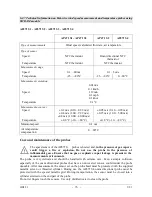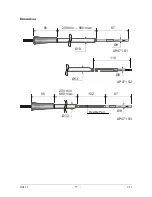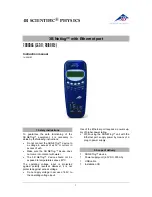
HD32.1
- 65 -
V2.1
Performing the measurement
The tripod and required probes are assembled where you wish to perform the measurement. Then
you need to setup the instrument and start the measurement. If you have to carry out the
measurement s in another location, you need to move everything in that new location.
At the end of the measurement session, or later, the data are transferred to a PC for processing and
reports.
6.1.1 Warnings, care and maintenance of the probes
•
Do not expose the probes to gases or liquids that could corrode the material of the probe. Clean
the probes carefully after each measurement.
•
Do not bend the probe connectors or force them upward or downward.
•
Comply with the correct polarity of the probes.
•
Do not bend or force the contacts when inserting the probe connector into the instrument.
•
Do not bend, deform or drop the probes, as this could cause irreparable damage.
•
Always select the most suitable probe for your application.
•
To obtain reliable measurements, temperature variations that are too rapid must be avoided.
•
Some probes are not insulated from their external casing; be very careful not to come
into contact with live parts (above 48V). This could be extremely dangerous for the
instrument as well as for the operator, who could be electrocuted.
•
Avoid taking measurements in presence of high frequency sources, microwave ovens or large
magnetic fields; results may not be very reliable.
•
The instrument is water resistant, but should not be immersed in water. Should the instrument
fall into the water, check for any water infiltration.
Wind speed hot-wire sensor AP3203
•
The wind speed hot-wire sensor AP3203 is heated and,
in the presence of gas
vapors, could trigger a fire or explosion. Do not use the probe in the presence of
inflammable gases. Ensure that no potentially explosive gas or vapor leakage is
present in the measurement environments
.
•
The probe is delicate and should be handled with extreme care.
As the sensor is only
partially protected during use, a simple collision could render the probe unusable.
•
After measurement, the sensor set on the probe head must be protected with the supplied
threaded cylinder.
•
During use, the AP3203 omni directional probe must be protected with the special metallic
sphere.
•
The sphere protection must be removed after use, and the sensor must be closed into the special
protection cylinder.
•
Do not let fingers touch the sensors.
•
Use only distilled water to
clean
the probe.
Summary of Contents for HD32.1
Page 6: ...HD32 1 6 V2 1 Thermal Microclimate HD32 1...
Page 78: ...HD32 1 78 V2 1 MIN 350 MAX 1020 120 AP471 S4...
Page 106: ...HD32 1 106 V2 1 Moderate Environment Norm ISO 7730...
Page 107: ...HD32 1 107 V2 1 Moderate Environment Norm ISO 7730...
Page 108: ...HD32 1 108 V2 1 Moderate Environment Norm ISO 7730...
Page 109: ...HD32 1 109 V2 1 Moderate Environment Norm ISO 7730...
Page 110: ...HD32 1 110 V2 1 Moderate Environment Norm ISO 7730...
Page 111: ...HD32 1 111 V2 1 Moderate Environment Norm ISO 7730...
Page 112: ...HD32 1 112 V2 1 12 2 WARM ENVIRONMENT Norm ISO 7243 Norm ISO 7243...
Page 113: ...HD32 1 113 V2 1 Warm Environment Norm ISO 7243...
Page 114: ...HD32 1 114 V2 1 Warm Environment Norm ISO 7243 Norm ISO 7243...
Page 115: ...HD32 1 115 V2 1 Warm Environment Norm ISO 7243...
Page 116: ...HD32 1 116 V2 1 Warm Environment Norm ISO 7243...
Page 117: ...HD32 1 117 V2 1 Warm Environment Norm ISO 7243...
Page 118: ...HD32 1 118 V2 1 12 3 DISCOMFORT ANALYSIS Norm ISO 7730 Norm ISO 7730...
Page 119: ...HD32 1 119 V2 1 Discomfort Analysis Norm ISO 7730...
Page 120: ...HD32 1 120 V2 1 Discomfort Analysis Norm ISO 7730...
Page 121: ...HD32 1 121 V2 1 Discomfort Analysis Norm ISO 7730...
Page 122: ...HD32 1 122 V2 1 Discomfort Analysis Norm ISO 7730...
Page 123: ...HD32 1 123 V2 1 Discomfort Analysis Norm ISO 7730...
Page 124: ...HD32 1 124 V2 1 Discomfort Analysis Norm ISO 7730...
Page 125: ...HD32 1 125 V2 1 12 4 HOT ENVIRONMENT Norm ISO 7933 Norm ISO 7933...
Page 126: ...HD32 1 126 V2 1 Hot Environment Norm ISO 7933...
Page 127: ...HD32 1 127 V2 1 Hot Environment Norm ISO 7933...
Page 128: ...HD32 1 128 V2 1 Hot Environment Norm ISO 7933...
Page 129: ...HD32 1 129 V2 1 Hot Environment Norm ISO 7933...
Page 130: ...HD32 1 130 V2 1 Hot Environment Norm ISO 7933...
Page 131: ...HD32 1 131 V2 1 Hot Environment Norm ISO 7933...
Page 132: ...HD32 1 132 V2 1 12 5 COLD ENVIRONMENT Norm ISO 11079 Norm ISO 11079...
Page 133: ...HD32 1 133 V2 1 Cold Environment Norm ISO 11079...
Page 134: ...HD32 1 134 V2 1 Cold Environment Norm ISO 11079...
Page 135: ...HD32 1 135 V2 1 Cold Environment Norm ISO 11079...
Page 136: ...HD32 1 136 V2 1 Cold Environment Norm ISO 11079...
Page 137: ...HD32 1 137 V2 1 Cold Environment Norm ISO 11079...
Page 138: ...HD32 1 138 V2 1 Cold Environment Norm ISO 11079...
Page 139: ...HD32 1 139 V2 1 Cold Environment Norm ISO 11079...
Page 140: ...HD32 1 140 V2 1 12 6 PHYSICAL QUANTITIES...
Page 153: ...HD32 1 153 V2 1 NOTES...
Page 154: ...HD32 1 154 V2 1 NOTES...
Page 155: ......













































